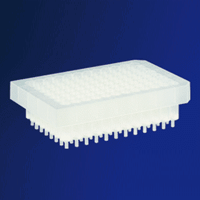Monoclonal antibodies (mAbs) are a growing class of therapeutic agents used for targeted treatment of cancer and neurodegenerative diseases, among other conditions. Therefore, the development of methods to efficiently and rapidly clone, express, and screen mAbs is crucial, as the initial screening process can involve thousands of mAbs. Workflows that involve isolating cDNAs from variable regions of individual B cells and then cloning those regions into expression vectors have grown in popularity. While this method requires just a single round of cloning, use of traditional cloning and expression protocols can limit the number of antibodies being generated.
Traditional cloning presents several constraints which limit its scalability for higher-throughput workflows: low ligase efficiency (especially with larger DNA fragments), nucleotide scars, lack of directionality, and laborious vector and/or insert preparation. While low ligase efficiency and multistep fragment preparation can lengthen the overall workload by a few days, nucleotide scars and lack of directionality pose more serious problems, with the desired insert being cloned out of frame or in the wrong orientation, respectively. In general, these traditional methods add significant amounts of time to experimental setup and colony screening. Scaling up a workflow also means magnifying its potential problems and troubleshooting efforts. Minimizing such issues is critical for moving into applications that require thousands of clones.
In-Fusion Cloning is a ligation-free, highly efficient technology which lets researchers avoid the bottlenecks found when working within the constraints of traditional cloning. This seamless cloning method facilitates fast, accurate cloning of any PCR fragment(s) into any destination vector, with a success rate of over 95% for single-insert cloning. Background is low, and cloning is always directional, relying on homologous recombination between vector and insert to create final constructs. The speed and simplicity of the In-Fusion Cloning protocol, paired with the confidence in its results, makes the system easily adaptable to high-throughput workflows.
The workflow figure here shows just one basic example of how In-Fusion technology can be scaled up for cloning in 96-well plates, either manually or with automation platforms. While this workflow includes our recommended step of plating transformed cells to ensure a clonal population, in the study detailed below, researchers at Morphotek, Inc. found they were able to skip this step entirely. With the high accuracy of In-Fusion Cloning at their disposal, they developed their own high-throughput process for the rapid generation of antibodies, further streamlining the workflow with an alternative outgrowth method (Spidel, J.L. et al. 2016).







